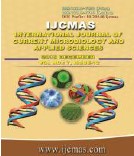


 National Academy of Agricultural Sciences (NAAS)
National Academy of Agricultural Sciences (NAAS)

|
PRINT ISSN : 2319-7692
Online ISSN : 2319-7706 Issues : 12 per year Publisher : Excellent Publishers Email : editorijcmas@gmail.com / submit@ijcmas.com Editor-in-chief: Dr.M.Prakash Index Copernicus ICV 2018: 95.39 NAAS RATING 2020: 5.38 |
Enterococcus faecalis is the main pathogen detached from failed root canals and insistent peri-apical lesion. It founds in anatomical structures that remain inside inaccessible areas for mechanical instrumentation like lateral canal and isthmus so, the root canal irrigation has an important role in the elimination of microbes in these inaccessible areas for instrumentation. Aim of the study is to compare between the efficiency of a newly introduced product of chlorhexidine gluconate as chemical root canal irrigant and hydroalcoholic extract of garlic herbal product against Enterococcus faecalis. This study was In-vitro used the agar diffusion method. Enterococcus faecalis was cultured on blood agar plate. Thirty three plates were divided into two group Positive and negative control used for verification of the results. Chlorhexidine used as a positive control since it is the commonly used irrigate. The zone of inhibition measured and expressed in millimeters. The results of antibacterial activity were expressed in terms of the diameter of the zone of inhibition. Statistical package for social sciences (SPSS) was used to analyze the data. A descriptive statistics calculated the efficiency of the irrigation solution against Enterococcus faecalis. Student’s T-Test was used. The efficacy of chlorhexidine gluconate was found to be significantly more (18.31±0.946) than Garlic extract (14.71±0.985) against Enterococcus faecalis and the difference was statistically significant p<0.05. 2% chlorhexidine gluconate was shown to inhibit the Enterococcus faecalis effectively. But garlic extract (allicin) as compare to chlorhexidine showed very minimal activity against E. faecalis.
 |
 |
 |
 |
 |